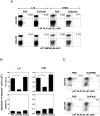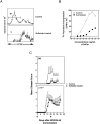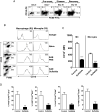Dendritic cells and anergic type I NKT cells play a crucial role in sulfatide-mediated immune regulation in experimental autoimmune encephalomyelitis
- PMID: 24973441
- PMCID: PMC4110642
- DOI: 10.4049/jimmunol.1302898
Dendritic cells and anergic type I NKT cells play a crucial role in sulfatide-mediated immune regulation in experimental autoimmune encephalomyelitis
Abstract
CD1d-restricted NKT cells can be divided into two groups: type I NKT cells use a semi-invariant TCR, whereas type II express a relatively diverse set of TCRs. A major subset of type II NKT cells recognizes myelin-derived sulfatides and is selectively enriched in the CNS tissue during experimental autoimmune encephalomyelitis (EAE). We have shown that activation of sulfatide-reactive type II NKT cells by sulfatide prevents induction of EAE. In this article, we have addressed the mechanism of regulation, as well as whether a single immunodominant form of synthetic sulfatide can treat ongoing chronic and relapsing EAE in SJL/J mice. We have shown that the activation of sulfatide-reactive type II NKT cells leads to a significant reduction in the frequency and effector function of myelin proteolipid proteins 139-151/I-A(s)-tetramer(+) cells in lymphoid and CNS tissues. In addition, type I NKT cells and dendritic cells (DCs) in the periphery, as well as CNS-resident microglia, are inactivated after sulfatide administration, and mice deficient in type I NKT cells are not protected from disease. Moreover, tolerized DCs from sulfatide-treated animals can adoptively transfer protection into naive mice. Treatment of SJL/J mice with a synthetic cis-tetracosenoyl sulfatide, but not α-galactosylceramide, reverses ongoing chronic and relapsing EAE. Our data highlight a novel immune-regulatory pathway involving NKT subset interactions leading to inactivation of type I NKT cells, DCs, and microglial cells in suppression of autoimmunity. Because CD1 molecules are nonpolymorphic, the sulfatide-mediated immune-regulatory pathway can be targeted for development of non-HLA-dependent therapeutic approaches to T cell-mediated autoimmune diseases.
Copyright © 2014 by The American Association of Immunologists, Inc.
Figures







Similar articles
-
Sulfatide administration leads to inhibition of HIV-1 replication and enhanced hematopoeisis.J Stem Cells. 2010;5(1):33-42. J Stem Cells. 2010. PMID: 20861926
-
Type II NKT cell-mediated anergy induction in type I NKT cells prevents inflammatory liver disease.J Clin Invest. 2007 Aug;117(8):2302-12. doi: 10.1172/JCI31602. J Clin Invest. 2007. PMID: 17641782 Free PMC article.
-
Sulfatide-activated type II NKT cells suppress immunogenic maturation of lung dendritic cells in murine models of asthma.Am J Physiol Lung Cell Mol Physiol. 2019 Nov 1;317(5):L578-L590. doi: 10.1152/ajplung.00256.2018. Epub 2019 Aug 21. Am J Physiol Lung Cell Mol Physiol. 2019. PMID: 31432714
-
Type II NKT cells: a distinct CD1d-restricted immune regulatory NKT cell subset.Immunogenetics. 2016 Aug;68(8):665-76. doi: 10.1007/s00251-016-0930-1. Epub 2016 Jul 12. Immunogenetics. 2016. PMID: 27405300 Free PMC article. Review.
-
Cross-regulation between distinct natural killer T cell subsets influences immune response to self and foreign antigens.J Cell Physiol. 2009 Feb;218(2):246-50. doi: 10.1002/jcp.21597. J Cell Physiol. 2009. PMID: 18814145 Free PMC article. Review.
Cited by
-
T cells from MS Patients with High Disease Severity Are Insensitive to an Immune-Suppressive Effect of Sulfatide.Mol Neurobiol. 2022 Sep;59(9):5276-5283. doi: 10.1007/s12035-022-02881-9. Epub 2022 Jun 11. Mol Neurobiol. 2022. PMID: 35689766
-
Innate, innate-like and adaptive lymphocytes in the pathogenesis of MS and EAE.Cell Mol Immunol. 2019 Jun;16(6):531-539. doi: 10.1038/s41423-019-0221-5. Epub 2019 Mar 15. Cell Mol Immunol. 2019. PMID: 30874627 Free PMC article. Review.
-
The Janus Face of NKT Cell Function in Autoimmunity and Infectious Diseases.Int J Mol Sci. 2018 Feb 1;19(2):440. doi: 10.3390/ijms19020440. Int J Mol Sci. 2018. PMID: 29389901 Free PMC article. Review.
-
IL-10 Production Is Critical for Sustaining the Expansion of CD5+ B and NKT Cells and Restraining Autoantibody Production in Congenic Lupus-Prone Mice.PLoS One. 2016 Mar 10;11(3):e0150515. doi: 10.1371/journal.pone.0150515. eCollection 2016. PLoS One. 2016. PMID: 26964093 Free PMC article.
-
Type II NKT Cells and Their Emerging Role in Health and Disease.J Immunol. 2017 Feb 1;198(3):1015-1021. doi: 10.4049/jimmunol.1601399. J Immunol. 2017. PMID: 28115591 Free PMC article. Review.
References
-
- Bendelac A, Savage PB, Teyton L. The biology of NKT cells. Annu Rev Immunol. 2007;25:297–336. - PubMed
-
- Brigl M, Brenner MB. CD1: antigen presentation and T cell function. Annu Rev Immunol. 2004;22:817–890. - PubMed
-
- Kronenberg M, Rudensky A. Regulation of immunity by self-reactive T cells. Nature. 2005;435:598–604. - PubMed
Publication types
MeSH terms
Substances
Grants and funding
LinkOut - more resources
Full Text Sources
Other Literature Sources
Research Materials

